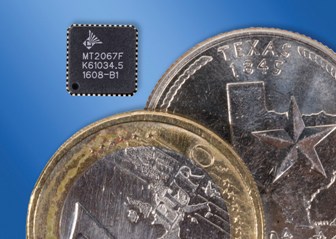Microtune Has New Chip for Mobile TV
The headline in the Microtune press release announcing its MT2067 tuner for automotive DTV reads, “World-Standard Automotive-Grade Tuner Engineered to Deliver Superior TV Broadcast Reception in Vehicles Traveling up to 200 km/hour (125 miles/hour).”
The MT2067 supports NTSC, PAL, SECAM, DVB-T, DVB-H, ISDB-T, ATSC and ATSC-M/H. The MT2067 is a tuner, not a demodulator, so the “200 km/hour” claim is somewhat misleading. That doesn't mean, however, that the MT2067 is just another silicon tuner.

The Microtune MT2067 tuner
The MT2067 was designed for the demanding mobile environment. It includes an integrated low noise amplifier (LNA) and has an AGC range of more than 100 dB. This allows it to handle the wide range of signal levels encountered in mobile reception. The MT2067, like other Microtune tuners, uses double conversion.
Double conversion allows the tuner to reject interference from other channels without the need for an external tracking filter. The MT2067 datasheet lists a typical input noise figure of 5.5 dB and image rejection at 70 dB. Microtune's ClearTune technology improves rejection of adjacent channels.
For use in automobiles, devices need to operate over a wide temperature range while enduring high humidity and vibration. Microtune says the MT2067 is qualified in accordance with the AEC-Q100 specification for automotive devices. The MT2067 has low spurious emissions and is designed to be used in receivers employing multiple tuners to provide diversity reception and reduce the impact of the Doppler Effect. The Doppler Effect creates problems for high speed mobile DTV. See the Microtune white paper for more information on mobile TV reception.
“We combined our silicon RF expertise with our automotive heritage and experience to develop a dedicated automotive TV tuner that yields significant performance, reliability, size and cost benefits,” said James A. Fontaine, president and CEO of Microtune. “As with our recently announced MT1119 antenna amplifier, the MT2067 is part of a new portfolio of highly integrated RF silicon technology products targeted for the automotive market. It is engineered specifically to meet the complex, rigorous technical, operating and qualification requirements of our automotive customers, providing an advanced electronics solution as the industry strives to deliver competitive entertainment value and options to ever-more demanding consumers."
Read more of RF Reporthere.
Get the TV Tech Newsletter
The professional video industry's #1 source for news, trends and product and tech information. Sign up below.

Doug Lung is one of America's foremost authorities on broadcast RF technology. As vice president of Broadcast Technology for NBCUniversal Local, H. Douglas Lung leads NBC and Telemundo-owned stations’ RF and transmission affairs, including microwave, radars, satellite uplinks, and FCC technical filings. Beginning his career in 1976 at KSCI in Los Angeles, Lung has nearly 50 years of experience in broadcast television engineering. Beginning in 1985, he led the engineering department for what was to become the Telemundo network and station group, assisting in the design, construction and installation of the company’s broadcast and cable facilities. Other projects include work on the launch of Hawaii’s first UHF TV station, the rollout and testing of the ATSC mobile-handheld standard, and software development related to the incentive auction TV spectrum repack. A longtime columnist for TV Technology, Doug is also a regular contributor to IEEE Broadcast Technology. He is the recipient of the 2023 NAB Television Engineering Award. He also received a Tech Leadership Award from TV Tech publisher Future plc in 2021 and is a member of the IEEE Broadcast Technology Society and the Society of Broadcast Engineers.
